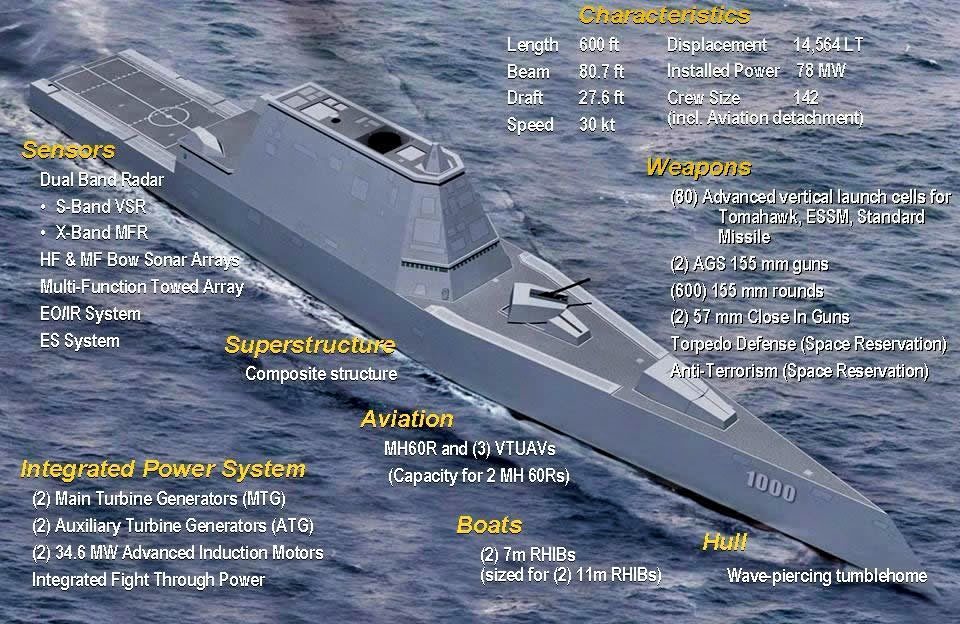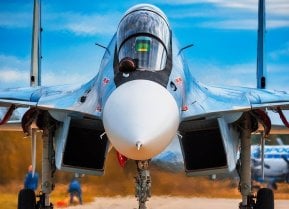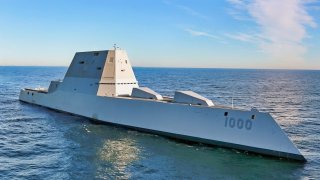Navy Zumwalt-class Stealth Destroyer: Armed with Hypersonic Missiles?
Once updated, the Zumwalt-class destroyers will reportedly be capable of performing a range of deterrence, power projection, sea control, and command and control missions while allowing the U.S. Navy to evolve with new systems and missions.
Will Hypersonic Missiles Save the Zumwalt-class Stealth Destroyer? - In August 2023, HII's Ingalls Shipbuilding division announced that it was awarded a $154.8 million contract modification for the modernization of USS Zumwalt (DDG 1000).
Though a "modernization" of military platforms is routinely carried out – it is typically on systems that have been in service for a decade or longer. In the case of the Zumwalt-class of United States Navy destroyers, the warships have only recently entered service.
Yet, the vessel arrived in Pascagoula, Mississippi on August 19 from San Diego, where the contractor began to replace the current 155mm twin gun system with the Conventional Prompt Strike (CPS) weapon system, a conventional, boost-glide hypersonic weapon system.
The all-up-round missile includes a two-stage solid rocket motor booster and a Common Hypersonic Glide Body containing a kinetic energy projectile warhead.
This is essentially an effort to "save" the Zumwalt-class.
Zumwalt: The Wrong Class of Warship?
Designed as a new class of multi-mission stealth warships with a focus on land attacks, the sleek Zumwalt-Class was also meant to be able to take on secondary roles including surface and anti-aircraft warfare.
The next-generation, multi-mission destroyers were developed with a state-of-the-art electric propulsion system, wave-piercing tumblehome hull, stealth design, and the latest war-fighting technology and weaponry.
Questions have been asked whether the ship packed in too much new technology. Looking like something out of science fiction, the new vessels were truly state-of-the-art and cutting-edge, but history has shown that new designs can be problematic.
Classed as destroyers, the Zumwalt-class was designed to be larger than any active destroyer or even cruiser but also met the congressional mandate for a warship that has the naval fire support of a battleship.

The new vessels were also developed to be capable of performing a range of deterrence, power projection, sea control, and command and control missions – and were designed to operate in both the open ocean and near-shore environments.
The streamlined, wave-piercing tumblehome hull has a "knife-like profile," which provides the 600-foot-long warship class with the radar signature of a fishing boat. And despite concerns over the stability of the hull, when it was tested in January 2020 off the coast of Alaska the lead vessel of the class, USS Zumwalt (DDG-1000), handled rough waters as well – perhaps even better – as previous classes of destroyers.
Yet, a 2016 article in The National Review described the vessel as "an unmitigated disaster," after the $4 billion lead vessel broke down while passing through the Panama Canal just a month after it was commissioned.
That was just a portent of the larger problems that soon became clear for the Zumwalt-class.
The entire program also faced multiple delays and cost overruns, even as the Navy called the delivery of the warship a "major milestone."
It had originally planned to buy more than two dozen of the larger stealth destroyers, but that number was reduced to just three as costs ballooned and questions came up over what its role would actually be.
Zumwalt-Class: Gunning for Trouble?
At issue is exactly how the warships could accomplish their primary mission of land attacks. As a new generation of warships, the Zumwalt-class was designed to be fitted with two 155mm Advanced Gun Systems (AGS), which are capable of engaging targets with precision-guided shells at a range of up to 60 miles.
In wartime, the destroyers could use such an ability to engage targets from close to shore to create a path for an amphibious landing.
The problem is that the Long Range Land Attack Projectile, the precision-guided shell to be used in the AGS, ballooned in price from $50,000 to $800,000 for each round – making it simply too expensive to fire.
Hypersonic Solution
In 2022, the Navy Strategic Systems Programs awarded a $22.8 million contract to Lockheed Martin Space Systems to integrate hypersonic weapons aboard the three Zumwalt-class destroyers.
The defense contractor will provide missile production long-lead materials, program management, and system engineering for the Navy Conventional Prompt Strike Weapon System Platform-Specific Development and Production project.
In addition, the two massive 155mm Advanced Gun Systems aboard the trio of destroyers – which include DDG 1000, the USS Michael Monsoor (DDG 1001), and the USS Lyndon B. Johnson (DDG 1002) – will be completely removed. That will supersede a former plan that had called for leaving the AGS in place.
It will require significant modification to the three destroyers.
However, the CPS concept could extend the long-range strike capability for the U.S. Navy, as the hypersonic missiles would be able to strike nearly any target in the world in less than an hour. The focus would remain on attacking high-value or fleeting targets with extremely fast hypersonic weapons, which can fly faster than five times the speed of sound.
Once updated, the Zumwalt-class destroyers will reportedly be capable of performing a range of deterrence, power projection, sea control, and command and control missions while allowing the U.S. Navy to evolve with new systems and missions.
At least that's the plan.
Hypersonic Weapons – Not So Fast
The question is whether this will actually provide the warships with the right weapons – or is the U.S. Navy simply throwing good money after bad?
"This capability is far from popular due to how expensive, novel and unproven hypersonics remain," GlobalData Defence analyst Tristan Sauer told Naval Technology in September. "The US military's decision to integrate the CPS with Zumwalt DDGs is actually a significant step in the fielding of novel hypersonic designs, though with only $1.1bn this is very much still a 'trial' to see how well this system holds up on extended deployments before they decide to ramp up production and orders."
Author Experience and Expertise
Peter Suciu is a Michigan-based writer. He has contributed to more than four dozen magazines, newspapers, and websites with over 3,200 published pieces over a twenty-year career in journalism. He regularly writes about military hardware, firearms history, cybersecurity, politics, and international affairs. Peter is also a Contributing Writer for Forbes and Clearance Jobs. You can follow him on Twitter: @PeterSuciu.
All images are Creative Commons.


